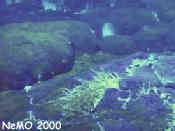| |
Participant
Interview:
Robert Boyd
Science Writer
Knight Ridder Inc.
Jeff: How long have you
been a science writer?
Robert: I've been writing science for about eight years. Before that I
did politics and general government in the Washington Bureau, but the
science writing is absolutely marvelous. You really feel you're on the
frontier of knowledge, that things are actually new. In government, things
seem to go in a cycle that repeats over and over again. Covering science,
you really feel your advancing the field of knowledge.
Jeff: How did you get on
the NeMO 2000 cruise?
Robert: I'd been hearing about oceanographic research for four or five
years. I went to a conference on the Juan de Fuca Ridge last November
in Seattle. They were discussing their results from last summer's cruise
and their plans for this year. At one point I got up and said, "You know,
NASA with their space writers, gets tremendous publicity but you guys
are almost unknown and have the most fascinating work. Why don't you take
me along?" They kind of laughed and said, "Well, that would be very nice,
but we don't have any room for you." A couple of weeks before this trip
I got a phone call from Bob Embley saying they had a cancellation, and
asked if I'd like to come? I practically jumped through the telephone
saying yes.
Jeff: What other scientific
expeditions have you been on?
Robert: I've had two extremely interesting ones. I spent two weeks at
NASA's Jet Propulsion Laboratory during the Mars Pathfinder landings when
the little robotic rover, Sojourner went around on Mars. It was wonderful.
The exhilaration and exuberance from the NASA engineers was great. Then,
last year I went to the Antarctic for 17 days and traveled to the South
Pole, the ice domes, and the famous dry valleys. We slept out in tents
and igloos and had a marvelous time. It was wonderful.
Jeff: What do you find
most interesting about the research at Axial?
Robert: I think that what fascinates me most is the concept of life in
and around the hydrothermal vents and even below the surface of the Earth's
crust; the sub-surface biosphere. It's really an extraordinary concept
that living things exist inside the Earth where there's no sun, no light.
It all depends on chemical energy. I'm also fascinated by the theory that
hydrothermal vents may be where life actually began on Earth and where
it might be found on other planets or moons.
|
|

Robert Boyd reporting
daily from the Ron Brown.

Tube worms and protozoan mats at Bluenose Vent (between Magnesia and Old
Worm Vents).
|
|

